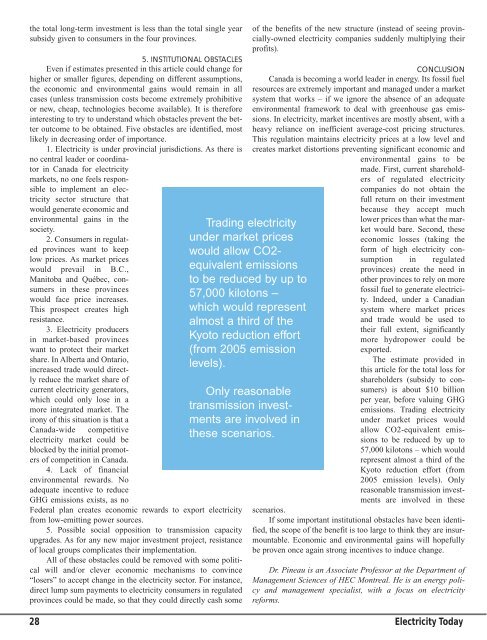in this issue - Electricity Today Magazine
in this issue - Electricity Today Magazine
in this issue - Electricity Today Magazine
Create successful ePaper yourself
Turn your PDF publications into a flip-book with our unique Google optimized e-Paper software.
the total long-term <strong>in</strong>vestment is less than the total s<strong>in</strong>gle year<br />
subsidy given to consumers <strong>in</strong> the four prov<strong>in</strong>ces.<br />
5. INSTITUTIONAL OBSTACLES<br />
Even if estimates presented <strong>in</strong> <strong>this</strong> article could change for<br />
higher or smaller figures, depend<strong>in</strong>g on different assumptions,<br />
the economic and environmental ga<strong>in</strong>s would rema<strong>in</strong> <strong>in</strong> all<br />
cases (unless transmission costs become extremely prohibitive<br />
or new, cheap, technologies become available). It is therefore<br />
<strong>in</strong>terest<strong>in</strong>g to try to understand which obstacles prevent the better<br />
outcome to be obta<strong>in</strong>ed. Five obstacles are identified, most<br />
likely <strong>in</strong> decreas<strong>in</strong>g order of importance.<br />
1. <strong>Electricity</strong> is under prov<strong>in</strong>cial jurisdictions. As there is<br />
no central leader or coord<strong>in</strong>ator<br />
<strong>in</strong> Canada for electricity<br />
markets, no one feels responsible<br />
to implement an electricity<br />
sector structure that<br />
would generate economic and<br />
environmental ga<strong>in</strong>s <strong>in</strong> the<br />
society.<br />
2. Consumers <strong>in</strong> regulated<br />
prov<strong>in</strong>ces want to keep<br />
low prices. As market prices<br />
would prevail <strong>in</strong> B.C.,<br />
Manitoba and Québec, consumers<br />
<strong>in</strong> these prov<strong>in</strong>ces<br />
would face price <strong>in</strong>creases.<br />
This prospect creates high<br />
resistance.<br />
3. <strong>Electricity</strong> producers<br />
<strong>in</strong> market-based prov<strong>in</strong>ces<br />
want to protect their market<br />
share. In Alberta and Ontario,<br />
<strong>in</strong>creased trade would directly<br />
reduce the market share of<br />
current electricity generators,<br />
which could only lose <strong>in</strong> a<br />
more <strong>in</strong>tegrated market. The<br />
irony of <strong>this</strong> situation is that a<br />
Canada-wide competitive<br />
electricity market could be<br />
blocked by the <strong>in</strong>itial promoters<br />
of competition <strong>in</strong> Canada.<br />
4. Lack of f<strong>in</strong>ancial<br />
environmental rewards. No<br />
adequate <strong>in</strong>centive to reduce<br />
GHG emissions exists, as no<br />
Federal plan creates economic rewards to export electricity<br />
from low-emitt<strong>in</strong>g power sources.<br />
5. Possible social opposition to transmission capacity<br />
upgrades. As for any new major <strong>in</strong>vestment project, resistance<br />
of local groups complicates their implementation.<br />
All of these obstacles could be removed with some political<br />
will and/or clever economic mechanisms to conv<strong>in</strong>ce<br />
“losers” to accept change <strong>in</strong> the electricity sector. For <strong>in</strong>stance,<br />
direct lump sum payments to electricity consumers <strong>in</strong> regulated<br />
prov<strong>in</strong>ces could be made, so that they could directly cash some<br />
28<br />
Trad<strong>in</strong>g electricity<br />
under market prices<br />
would allow CO2equivalent<br />
emissions<br />
to be reduced by up to<br />
57,000 kilotons –<br />
which would represent<br />
almost a third of the<br />
Kyoto reduction effort<br />
(from 2005 emission<br />
levels).<br />
Only reasonable<br />
transmission <strong>in</strong>vestments<br />
are <strong>in</strong>volved <strong>in</strong><br />
these scenarios.<br />
of the benefits of the new structure (<strong>in</strong>stead of see<strong>in</strong>g prov<strong>in</strong>cially-owned<br />
electricity companies suddenly multiply<strong>in</strong>g their<br />
profits).<br />
CONCLUSION<br />
Canada is becom<strong>in</strong>g a world leader <strong>in</strong> energy. Its fossil fuel<br />
resources are extremely important and managed under a market<br />
system that works – if we ignore the absence of an adequate<br />
environmental framework to deal with greenhouse gas emissions.<br />
In electricity, market <strong>in</strong>centives are mostly absent, with a<br />
heavy reliance on <strong>in</strong>efficient average-cost pric<strong>in</strong>g structures.<br />
This regulation ma<strong>in</strong>ta<strong>in</strong>s electricity prices at a low level and<br />
creates market distortions prevent<strong>in</strong>g significant economic and<br />
environmental ga<strong>in</strong>s to be<br />
made. First, current shareholders<br />
of regulated electricity<br />
companies do not obta<strong>in</strong> the<br />
full return on their <strong>in</strong>vestment<br />
because they accept much<br />
lower prices than what the market<br />
would bare. Second, these<br />
economic losses (tak<strong>in</strong>g the<br />
form of high electricity consumption<br />
<strong>in</strong> regulated<br />
prov<strong>in</strong>ces) create the need <strong>in</strong><br />
other prov<strong>in</strong>ces to rely on more<br />
fossil fuel to generate electricity.<br />
Indeed, under a Canadian<br />
system where market prices<br />
and trade would be used to<br />
their full extent, significantly<br />
more hydropower could be<br />
exported.<br />
The estimate provided <strong>in</strong><br />
<strong>this</strong> article for the total loss for<br />
shareholders (subsidy to consumers)<br />
is about $10 billion<br />
per year, before valu<strong>in</strong>g GHG<br />
emissions. Trad<strong>in</strong>g electricity<br />
under market prices would<br />
allow CO2-equivalent emissions<br />
to be reduced by up to<br />
57,000 kilotons – which would<br />
represent almost a third of the<br />
Kyoto reduction effort (from<br />
2005 emission levels). Only<br />
reasonable transmission <strong>in</strong>vestments<br />
are <strong>in</strong>volved <strong>in</strong> these<br />
scenarios.<br />
If some important <strong>in</strong>stitutional obstacles have been identified,<br />
the scope of the benefit is too large to th<strong>in</strong>k they are <strong>in</strong>surmountable.<br />
Economic and environmental ga<strong>in</strong>s will hopefully<br />
be proven once aga<strong>in</strong> strong <strong>in</strong>centives to <strong>in</strong>duce change.<br />
Dr. P<strong>in</strong>eau is an Associate Professor at the Department of<br />
Management Sciences of HEC Montreal. He is an energy policy<br />
and management specialist, with a focus on electricity<br />
reforms.<br />
<strong>Electricity</strong> <strong>Today</strong>












